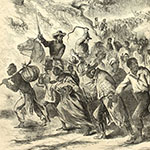 |
“Negroes Driven South by the Rebel Officers,” Harper’s Weekly (November 8, 1862).
As news of the preliminary Proclamation’s freedom provisions spread quickly throughout the South, slaveholders in Virginia feared losing their human property to the advancing Union army. Harper’s Weekly reported that Confederate soldiers were assigned to drive slaves farther south, often at the point of a bayonet, prior to the impending January 1, 1863, deadline. This engraving presents a visual composite of several correspondents’ eyewitness reports. |
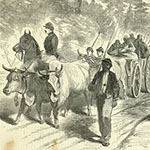 |
“The Effects of the Proclamation—Freed Negroes Coming into Our Lines at Newbern, North Carolina,” Harper’s Weekly (February 21, 1863).
Less than a month after Lincoln delivered the final Emancipation Proclamation on January 1, 1863, a member of the 51st Massachusetts Regiment in North Carolina sketched a scene of 120 escaping slaves who sought refuge behind Union lines. According to the account, which accompanied the illustration in Harper’s Weekly, the former slaves reported that “It was known far and wide that the President has declared the slaves free.” |
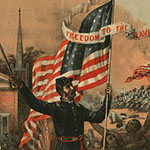
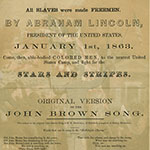
|
Freedom to the Slave/All Slaves Were Made Freemen. Philadelphia: Philadelphia Supervisory Committee for Recruiting Colored Regiments, 1863.
Until the Emancipation Proclamation, the U.S. Army largely turned away African American volunteers for military service. In 1863, the federal government finally formed the United States Colored Troops (U.S.C.T.), a segregated corps for both free and newly emancipated African American men. Targeted toward African Americans, this Union recruitment poster illustrates the new freedoms made possible by the Proclamation. |
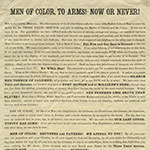 |
Men of Color, to Arms! Now or Never! [Philadelphia, 1863].
With the Civil War transformed into a war of liberation, Frederick Douglass and other prominent African Americans recruited black men to fight for the Union to prove their worth as citizens and to hasten slavery’s demise. |
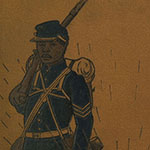 |
George Washington Williams. A History of the Negro Troops in the War of the Rebellion, 1861-1865: Preceded by a Review of the Military Services of Negroes in Ancient and Modern Times. New York: Harper & Brothers, 1888.
George Washington Williams (1849-1891) served in the United States Colored Troops during the Civil War, having enlisted under a false name because he was underage. More than two decades later, Williams wrote this history because accounts of African American soldiers were largely absent from Civil War histories. Not content to rely on his personal experiences of the war, Williams conducted extensive research in archives and libraries around the country. On the book’s cover, the Emancipation Proclamation shatters the chains of slavery while an African American soldier stands ready for battle in his Union uniform. |
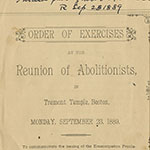 |
Order of Exercises at the Reunion of Abolitionists in Tremont Temple, Boston, Monday, September 23, 1889. To Commemorate the Issuing of the Emancipation Proclamation by President Lincoln, September 22, 1862. [Boston]: S. Woodberry & Co., [1889].
Frederick Douglass (1818-1895) and William Lloyd Garrison (1838-1909), the son of the late William Lloyd Garrison (1805-1879), were among the dignitaries scheduled to speak at this anniversary of the preliminary Emancipation Proclamation, indicating the continuing symbolic importance of September 22, 1862, among abolitionists. |






